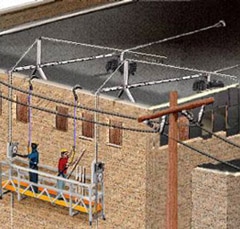Two-point adjustable suspension scaffolding, also known as “swing-stage” scaffolds, are perhaps the most common type of suspended scaffold. Hung by ropes or cables connected to stirrups at each end of the platform, they play a prominent role in high-rise construction.
 Their platforms are suspended by ropes, or other non-rigid means, from an overhead structure. Each cable suspension line is considered to be one point.
Their platforms are suspended by ropes, or other non-rigid means, from an overhead structure. Each cable suspension line is considered to be one point.
Safety First
OSHA provides a number of guidelines to assure the safety of workers and bystanders. Here are a few:
- Platforms on two-point adjustable suspension scaffolds must be no more than 36 inches wide, unless a qualified person has designed them to prevent unstable conditions.
- The platform must be securely fastened to hangers (stirrups) by U-bolts, or by other means that make it capable of supporting its own weight and at least 4 times its maximum intended load.
- Scaffold platforms and walkways must be at least 18 inches wide, unless they are used in areas that the contractor can demonstrate the requirement for a narrower platform. In such cases, the platforms must be as wide as feasible, and fall protection must be provided.
- Platforms 40 feet or less in length, and light metal-type platforms with a rated capacity of 750 pounds or less, must be tested and listed by a nationally recognized testing laboratory.
- Nothing that could cause a slip, trip or fall (i.e. tools, scrap material, chemicals, snow, ice, etc.) is allowed to accumulate on the platform.
- Customarily, ladders may not be used on scaffolds to increase the height of the working level, except on large-area scaffolds where employees have met safety certain criteria.
- For most activities, there must be no more than a 14-inch gap between the scaffold platform and the structure being worked on.
For a complete list of scaffolding safety guidelines, visit the official OSHA website on the subject.


